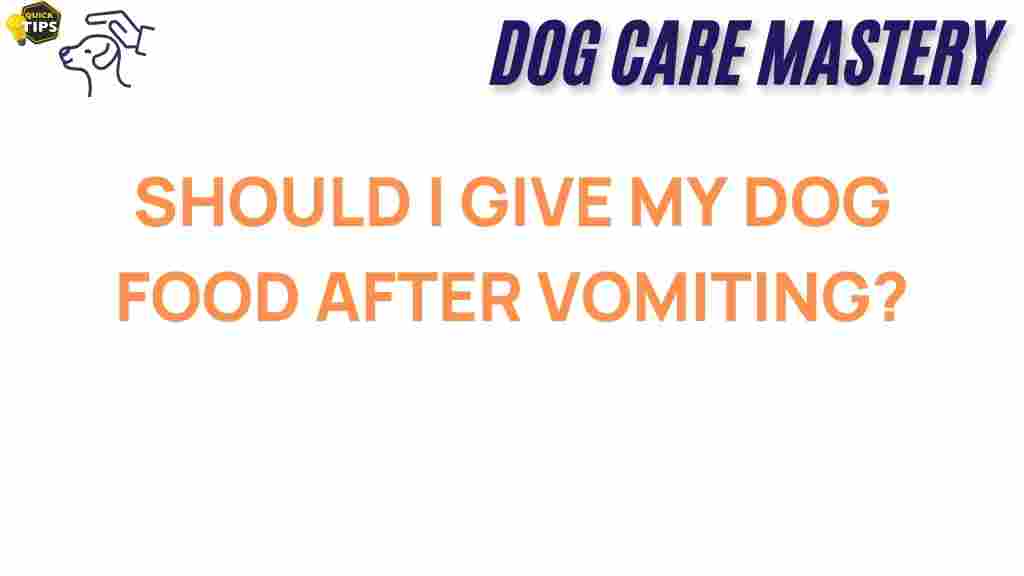Dog Health: The Dilemma of Feeding Your Dog After Vomiting
As a dog owner, few things are more concerning than when your furry friend throws up. It can be alarming, and you may find yourself wondering whether it’s safe to feed your dog after they vomit. Understanding the implications for your dog’s health in these situations is crucial. In this article, we will explore the best practices for handling your dog’s vomiting, what it means for their health, and how to ensure they recover smoothly.
Understanding the Causes of Vomiting in Dogs
Before making any decisions about feeding your dog after they vomit, it’s essential to understand why they vomited in the first place. Vomiting in dogs can occur for several reasons, including:
- Dietary indiscretion: Dogs often eat things they shouldn’t, leading to vomiting.
- Food allergies: Some dogs have sensitivities to certain ingredients.
- Infections: Bacterial or viral infections can upset a dog’s stomach.
- Illnesses: Conditions like pancreatitis or kidney disease may cause vomiting.
- Stress or anxiety: Emotional distress can also lead to stomach issues.
If your dog vomits occasionally, it may not be a cause for concern. However, frequent vomiting can indicate a more serious issue. Always monitor your dog’s health and consult a veterinarian if the vomiting persists.
What to Do Immediately After Your Dog Vomits
When your dog vomits, it’s essential to stay calm and assess the situation. Here’s a step-by-step process to follow:
- Observe your dog: Take note of how your dog behaves after vomiting. Are they lethargic? Are they still interested in food or water?
- Check for additional symptoms: Look for signs of distress, such as diarrhea, bloating, or excessive drooling.
- Withhold food and water: For the first few hours after vomiting, it’s often best to withhold food and water to give your dog’s stomach a chance to settle.
- Reintroduce water: After a few hours, if your dog seems stable, offer small amounts of water. If they can keep it down, you can gradually introduce food.
- Choose bland food: If your dog is ready to eat, offer bland food like boiled chicken and rice. Avoid their regular kibble at first.
When to Consult a Veterinarian
While many cases of vomiting can be treated at home, some situations require professional attention. You should consult a veterinarian if:
- Your dog vomits more than once in 24 hours.
- There are signs of distress, such as pacing, whining, or hiding.
- Your dog is lethargic or unresponsive.
- You notice blood in the vomit or stool.
- Your dog has pre-existing health conditions.
Prompt attention can be crucial for your dog’s health, so when in doubt, don’t hesitate to reach out to a professional.
How to Safely Feed Your Dog After Vomiting
If your dog seems to have settled after their vomiting episode, you may want to reintroduce food. Here’s how to do it safely:
- Start with small portions: Offer a small amount of bland food (like boiled chicken or rice) and see how your dog reacts.
- Gradually increase portions: If your dog keeps the food down, gradually increase the portion size over the next few meals.
- Monitor your dog’s behavior: Keep an eye on your dog after they eat. If they vomit again, stop feeding them and consult a vet.
- Reintroduce regular food cautiously: After a day of eating bland food without issues, you can start mixing in their regular food.
Common Mistakes to Avoid
When dealing with a vomiting dog, there are several common mistakes you should avoid to ensure your dog’s well-being:
- Feeding immediately after vomiting: This can irritate the stomach further.
- Ignoring symptoms: Always be vigilant for other signs of illness and consult a vet if needed.
- Changing food too quickly: Sudden changes in diet can upset the stomach.
Home Remedies for Dog Vomiting
While it’s always best to consult a veterinarian for persistent vomiting, some home remedies can be helpful for occasional episodes:
- Ginger: A small amount of ginger can help soothe an upset stomach.
- Plain pumpkin: Canned pumpkin (not the spiced pie filling) can aid digestion.
- Probiotics: Adding probiotics to your dog’s diet can help restore gut health.
Always consult your veterinarian before trying home remedies, especially if your dog has underlying health issues.
Long-Term Considerations for Dog Health
To maintain your dog’s health and prevent future vomiting episodes, consider the following long-term strategies:
- Quality diet: Invest in high-quality dog food free from fillers and artificial ingredients.
- Regular vet check-ups: Routine vet visits can help catch potential health issues early.
- Consistent feeding schedule: Feed your dog at the same times each day to regulate their digestive system.
- Limit access to harmful foods: Ensure your dog doesn’t have access to human food that can cause digestive distress.
By focusing on your dog’s health, you can minimize the risk of vomiting and other gastrointestinal issues.
Conclusion
The decision to feed your dog after they vomit is not a straightforward one. While it’s essential to ensure your dog receives adequate nutrition, it’s equally important to consider their health and the underlying causes of vomiting. By following the guidelines outlined in this article, you can make informed decisions that prioritize your dog’s well-being. If you’re ever unsure, remember that consulting a veterinarian is always the best course of action.
For further information on dog health and nutrition, check out this comprehensive guide. And for more tips on keeping your dog healthy, visit our pet care blog.
This article is in the category Health and created by dogcaremastery Team
